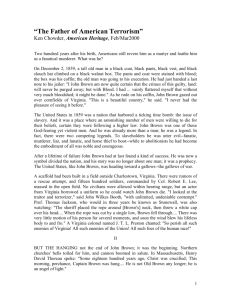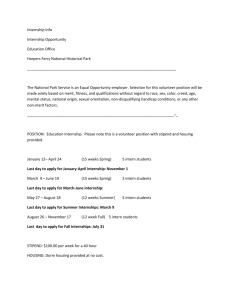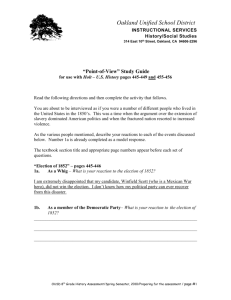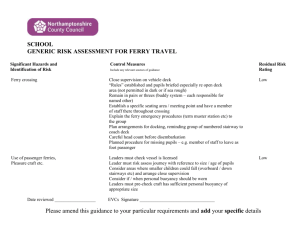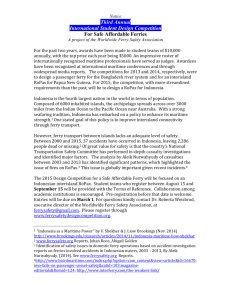Archeology Discovers the U.S. Musket Factory
advertisement
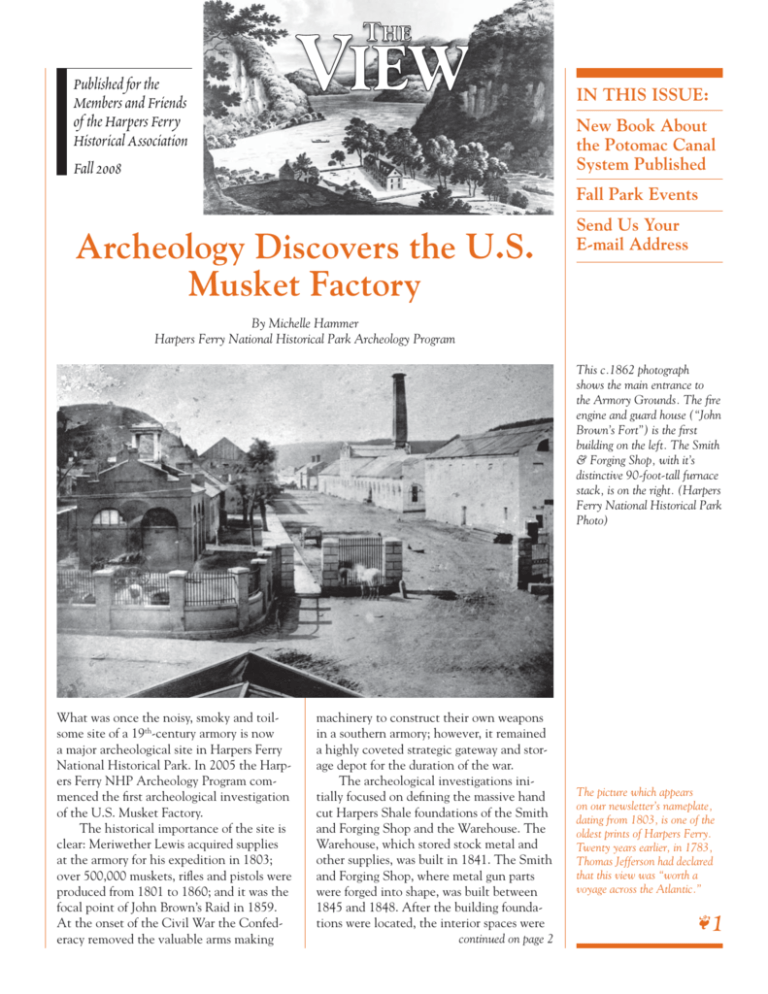
Published for the Members and Friends of the Harpers Ferry Historical Association Fall 2008 IN THIS ISSUE: New Book About the Potomac Canal System Published Fall Park Events Archeology Discovers the U.S. Musket Factory Send Us Your E-mail Address By Michelle Hammer Harpers Ferry National Historical Park Archeology Program This c.1862 photograph shows the main entrance to the Armory Grounds. The fire engine and guard house (“John Brown’s Fort”) is the first building on the left. The Smith & Forging Shop, with it’s distinctive 90-foot-tall furnace stack, is on the right. (Harpers Ferry National Historical Park Photo) What was once the noisy, smoky and toilsome site of a 19th-century armory is now a major archeological site in Harpers Ferry National Historical Park. In 2005 the Harpers Ferry NHP Archeology Program commenced the first archeological investigation of the U.S. Musket Factory. The historical importance of the site is clear: Meriwether Lewis acquired supplies at the armory for his expedition in 1803; over 500,000 muskets, rifles and pistols were produced from 1801 to 1860; and it was the focal point of John Brown’s Raid in 1859. At the onset of the Civil War the Confederacy removed the valuable arms making machinery to construct their own weapons in a southern armory; however, it remained a highly coveted strategic gateway and storage depot for the duration of the war. The archeological investigations initially focused on defining the massive hand cut Harpers Shale foundations of the Smith and Forging Shop and the Warehouse. The Warehouse, which stored stock metal and other supplies, was built in 1841. The Smith and Forging Shop, where metal gun parts were forged into shape, was built between 1845 and 1848. After the building foundations were located, the interior spaces were continued on page 2 The picture which appears on our newsletter’s nameplate, dating from 1803, is one of the oldest prints of Harpers Ferry. Twenty years earlier, in 1783, Thomas Jefferson had declared that this view was “worth a voyage across the Atlantic.” 1 Armory Superintendents 2007-2008: Jo (Kuhn) Curtis Brandywine, MD In memory of her son, Jim Kuhn Dr. Robert Johnson Harpers Ferry, WV Ronald Jones Our Lady of Sorrows School, Farmington, MI Paymasters 2007-2008 Nancy Myers Harpers Ferry, WV Jim & Suzanne Siliva Taunton, MA & Harpers Ferry, WV Master Armorers 2007-2008 Argero & Alfred Alsdorf Harpers Ferry, WV Kirk Bradley Sanford, NC Donald & Patricia Burgess Harpers Ferry, WV Honorable & Mrs. Thomas Curtis Baltimore, MD Clark & Ora Dixon Ranson, WV Kim & Frank Edwards Edgewood, MD Scot & Vicki Faulkner Harpers Ferry, WV Alexander and Deborah Fleming Harpers Ferry, WV James & Kathleen Goodlive Eureka, CA Wayne Hammond Saxon, PA Bernie Klemanek Chardon, OH Everett & Antigone Ladd Gettysburg, PA Anne Long Myersville, MD Charles “Chuck” Lord Houston, TX Cynthia Mason Baltimore, MD 2 Archeology Continued from Page 1 explored. In the Smith and Forging Shop, a deep horizontal shaft running the length of the floor was discovered. This feature was found to be a component of an experimental system outfitted with a metal pipe intended to supply air to the individual forges to fuel the fires in place of traditional bellows. The forge was historically the brick or stone hearth that held the smith’s fire. There were eight forges in each wing of the Smith and Forging shop. The shaft feature contained the highest concentration of artifacts on the site. In the laboratory, artifacts are analyzed in the context of where they were found in the layers of ground. There were 56,377 artifacts collected from the Musket Factory site. The items range from personal objects such as bone toothbrushes, buttons and lice Artifacts uncovered during excavation of the Smith & Forging Shop. Right: File modified to serve as a wrench. Below: Apothecary weight used to weigh medicine. Bottom: Bone toothbrush with initials carved into it. (National Park Service Digital Imaging Project) 1 cm 1 cm combs to gunsmith tools such as metal files used to shape gun parts, and anvil tools to industrial factory remains such as machinery gears and cast iron window frames. Slag and clinker, artifacts that are the telltale remnants of metalworking, litter the site. Slag may be studied to learn the quality of the supply metal used by the gunsmith and it can indicate the type of metalworking practiced. Prehistoric American Indian artifacts and features were also discovered in two areas on the outside of the buildings. The Armory workers were gunsmiths. Gunsmiths are highly specialized blacksmiths concerned with the production of arms. Large gun making facilities welcomed gun manufacturing machinery in the 19th century that could be operated by unskilled laborers. The change threatened the craft 1 cm Master Armorers (cont’d) Dr. Steven Nichols Shenandoah Junction, WV George Rutherford Ranson, WV Paul Schmoyer Orefield, PA Merritt Roe Smith Cambridge, MA Maureen Weber Falling Waters, WV Kathryn Wendt Chicago, IL Donations Above: Photo of the Smith & Forging Shop excavation from above, showing the shaft feature running through the center of the building (NPS Photo by Rob Brzostowski). Below: Photo of the Smith & Forging Shop excavation in December 2006 (NPS Photo by David T. Gilbert). traditions of gunsmiths; factory interiors and gunsmith tools reflect this change. In some of the older layers located, wood working tools were found alongside metalworking tools. In the early 19th-century factory shops, one building would house woodworkers and metalworkers. This was not the case in the later specialized shops like the Smith and Forging Shop where they only practiced metalworking. This site contains networks of architectural features that require further excavation to better understand the complexity of the industry. Large deposits of manufacturing debris and the exterior building landscape also have great research potential. The Archeology Program is planning to explore the remainder of the Musket Factory in the near future. Michelle Hammer is the lab manager and volunteer coordinator for the Harpers Ferry Archeology Program. She graduated from the University of Maryland Anthropology Program in 2000 and has been working for federal and county archeology programs for nine years. Sources consulted: Smith, Merrit Roe, Harpers Ferry Armory and the New Technology: The Challenge of Change. Cornell University Press. Ithaca, New York, 1977. Lee, Andrew, The U.S. Armory at Harpers Ferry: Historic Resource Study. Archeology Program, Harpers Ferry National Historical Park, 2006. Bruce Kramer Baltimore, MD Celinda Current Novato, CA The National Center for Civil War Photography Oldsmar, FL Christy Huddle Harpers Ferry, WV Dickinson College Carlisle, PA All-in-One Tours & Cruises, LLC Lancaster, PA Joy Oakes Arlington, VA Gettysburg College Gettysburg, PA Heritage Center of Lancaster County, Inc. Lancaster, PA Board of Education Washington County, PA Elizabeth F. Allen Bakerton, WV Solutions 21, Inc. Wadesboro, NC Georgetown Law Library Washington, DC Civil War Round Table of NY Jamaica Estates, NY Eastern Middle School Silver Spring, MD John P. Lewis Millwood, VA Waynesboro Area Industrial Heritage Trust Waynesboro, PA 3 New Book Published About the Potomac Canal System About the Author Dr. Kapsch Ph. D., Hon. AIA, ASCE, is the perfect person to research and write this study. He holds doctorates in American studies, engineering, and architecture, as well as master’s degrees in historic preservation and management. For fifteen years, Dr. Kapsch was chief of the Historic American Buildings Survey/Historic American Engineering Record, the U. S. government’s premier documentation program. His previous work includes several books on historic architecture and engineering, including Canals, an illustrated history on American canals published by W.W. Norton in 2004, and Monocacy Aqueduct on the Chesapeake and Ohio Canal. 4 When canals are mentioned at Harpers Ferry, everyone thinks of the Chesapeake and Ohio Canal that arrived here in 1833. However, there were a series of canals along the Potomac and Shenandoah Rivers prior to the arrival of the C& O Canal. Dr. Robert J. Kapsch tells the story of these bypass canals in his stunning new book, The Potomac Canal: George Washington and the Waterway West. This 374-page work is a history of the new nation’s first effort to link the rich western agricultural lands with the coastal ports cities of the east. The Potomac Canal was used to ship flour from mills in the foothills of Appalachia to the tidewater of the Chesapeake, where it was then transshipped to the Caribbean as trade for sugar and other goods. This trade soon became the basis of agricultural wealth in West Virginia’s Eastern panhandle and throughout the Appalachian Piedmont. Coal was also shipped via the canal system from the upper reaches of the Potomac River to workshops at Harpers Ferry and beyond. This industrial trade route laid the foundation for what would eventually become the Chesapeake and Ohio Canal and the Baltimore and Ohio Railroad. In 1754 young George Washington, spurred on by the need for transporting supplies that were required to defend against the French, explored the possibility of the Potomac River as a transportation route. Washington continued throughout his life to promote the Potomac as a link from Tidewater, Virginia to the Ohio Valley. The Potomac Company was eventually chartered in 1785 following the Revolutionary War, and James Rumsey was its first superintendent. Locks, bypass canals, and in-river sluices were all considered when trying to solve the navigational obstacles on the Potomac. Construction of the canals at strategic points along the river including Little Falls near Harpers Ferry, and Great Falls were accomplished in spite of many challenges. Inadequate work forces, bad weather, illnesses, untried technology, perpetually-needed maintenance, and financial difficulties all plagued progress. But once the bypass canal at Great Falls was completed in 1802, attention was directed toward developing lateral river systems including canals along the Shenandoah River, the Conococheague Creek, Antietam Creek, the Monocacy River and Seneca Creek. These would allow farmers to connect with the Potomac Canal to ship their goods. The efforts to build the four bypass canals and a river sluice along the Shenandoah River led to the formation of the new Shenandoah Company in 1815. The story of the politics and financial shenanigans of this company, alone, makes this book fascinating reading. The construction and navigation of these canals were frequently disrupted by flooding and drought. Railroads and toll roads replaced their usefulness and eventually, these canals would become part of the power canals for mills located on Virginius Island. By using surviving payroll records in the chapter, “Workers of the Potomac Company,” the author analyzes the workforce including a combination of wage laborers, slaves, indentured workers, and contractors. Names, wages, kinds of jobs and skills, and work habits and conditions revealed in this section are an interesting study. The chapter on operations discusses the commercial aspects, goods shipped, boats used, and industries. The chapter on maintenance reviews the constant battle of generating enough revenue to cover the intensive upkeep needed for the canals. The last chapter reviews criticisms leveled in the Commissioners Report of 1823 which laid the groundwork for the demise of the Potomac Company and the creation of the first Chesapeake and Ohio Convention. In 1828 the officers of the Potomac Company signed the document that allowed the C&O Canal Company the right to assume its obligations and all its property. After 43 years in operation, a new era began. This book is published by West Virginia University with a support grant from the West Virginia Humanities Council. The design and production is unusually fine and deserves note. Artwork from the period is beautifully reproduced. Rare historic maps and drawings, many from the author’s personal collection, have been meticulously replicated in a readable size. Dr. Kapsch has approached this study from many points of view, so this book can be enjoyed by all readers. It is a story for those interested in early American history and industry; trade, transportation, economics and politics; engineering, waterpower, and architecture. Endnotes with descriptive detail encourage further study. It is available for sale at the Book Shop. Harpers Ferry Historical Association Membership Application ❏ I wish to join the Harpers Ferry Historical Association (new member) ❏ I wish to renew my membership (renewal) Please enroll me in the following member category (check one): ❏ $25 Armory Worker – Basic membership for a family household. Benefits include a newsletter subscription, a 15% discount on all bookshop purchases, a vinyl decal, and invitations to annual meeting and events. ❏ $25 Sarah Jane Foster – An alternative basic membership for educators. Benefits include the above plus open house for teachers and discounts on programs for teachers. ❏ $45 Millwright – For those members who are frequent visitors to the park. Benefits are the same as Armory Worker category plus a 12-month Harpers Ferry Park entrance pass. ❏ $100 Master Armorer – A supporting membership category. Includes all benefits of the Millwright category plus a “My Home Towne” replica of the Harpers Ferry Train Station, member recognition in our newsletter and at our annual meeting, and a special tour. ❏ $250 Paymaster – For businesses, vendors or family donors who wish to contribute to the Association’s mission. Benefits include 15% discount on all bookshop purchases; a newsletter subscription; vinyl decal; invitations to annual meetings, events, and associationsponsored education programs; a 12-month park pass; “My Home Towne” replica; recognition in newsletter and at annual meeting; special tour; and additional membership card. ❏ $500 Armory Superintendent – For supporters (individual and corporate) who wish to perpetuate Association and Park education programs. Benefits include 15% discount on all bookshop purchases, a newsletter subscription, vinyl decals, invitations to annual meeting, events, and education programs, “My Home Towne” replica, recognition in the newsletter and at annual meeting, special tour, a National Park pass (for use in all parks) for individuals, and a display plaque for businesses. ❏ I am not interested in receiving member benefits, but I would like to make a contribution in the amount of ________ to aid the mission of the Harpers Ferry Historical Association. ❏ I am a Charter Member and would like to make a donation of ________. ❏ Check if this is a new address for you _____________________________________________ Name _____________________________________________ Address _____________________________________________ City State Zip _____________________________________________ Telephone _____________________________________________ E-mail Please clip and mail to: Harpers Ferry Historical Association P.O. Box 197 Harpers Ferry, WV 25425 Toll-free: 1-800-821-5206 Phone: (304) 535-6881 Fax: (304) 535-6749 Email: hfha@earthlink.net 5 The Harpers Ferry Historical Association operates the National Park Bookshop in Lower Town Harpers Ferry. Profits from sales are returned to the park to support interpretive and educational programs to enhance your visit. You are invited to join this unique organization and be a part of Harpers Ferry’s special family. For more information call (304) 535-6881 or send e-mail to: hfha@earthlink.net Harpers Ferry Historical Association Post Office Box 197 Harpers Ferry, WV 25425 Non-Profit Organization U.S. Postage PAID Harpers Ferry, WV 25425 Permit No. 12 ARPERS FERRY istorical Association EXECUTIVE DIRECTOR Deborah K. Piscitelli EDITOR David T. Gilbert BOARD OF DIRECTORS James Silvia, President Wayne Welty, Treasurer Anne Long Suzanne Silvia Midge Flinn Yost 8 Fall Park Events The popular park event, Election Day 1860, will be held again this year on Saturday, October 11. Join re-enactors as they portray the activities and define the issues of the November 1860 election. Participate in voting process as it was on the eve of the Civil War. Don’t miss this event, now held once every four years to coincide with the national election. Living history volunteers campaign during Election Day 1860 event. (NPS Photo) On October 12, the Association will hold a Tent Sale and host visiting authors on the green. Also, that day visitors can join U.S. Marines at the Engine House where John Brown was captured in 1859. For more information on these and other weekend events, consult the park website, www.nps.gov/hafe. Members: Please Send Us Your E-mail Address! Because of the continuing increases in the cost of mailing and printing, we would like to transition to e-newsletters for those who have e-mail addresses. Also, this would give us the opportunity to provide you with more frequent and timely communication, and color photos. This will also allow us to notify you of renewal information by e-mail. For those of you without e-mail we will continue to send a printed newsletter. Please send your current e-mail address to hfha@earthlink.net. As always, we never share any personal contact information with anyone. We will only use your address to communicate association and park information. If you have any questions, please call us at (304) 535-6881.
